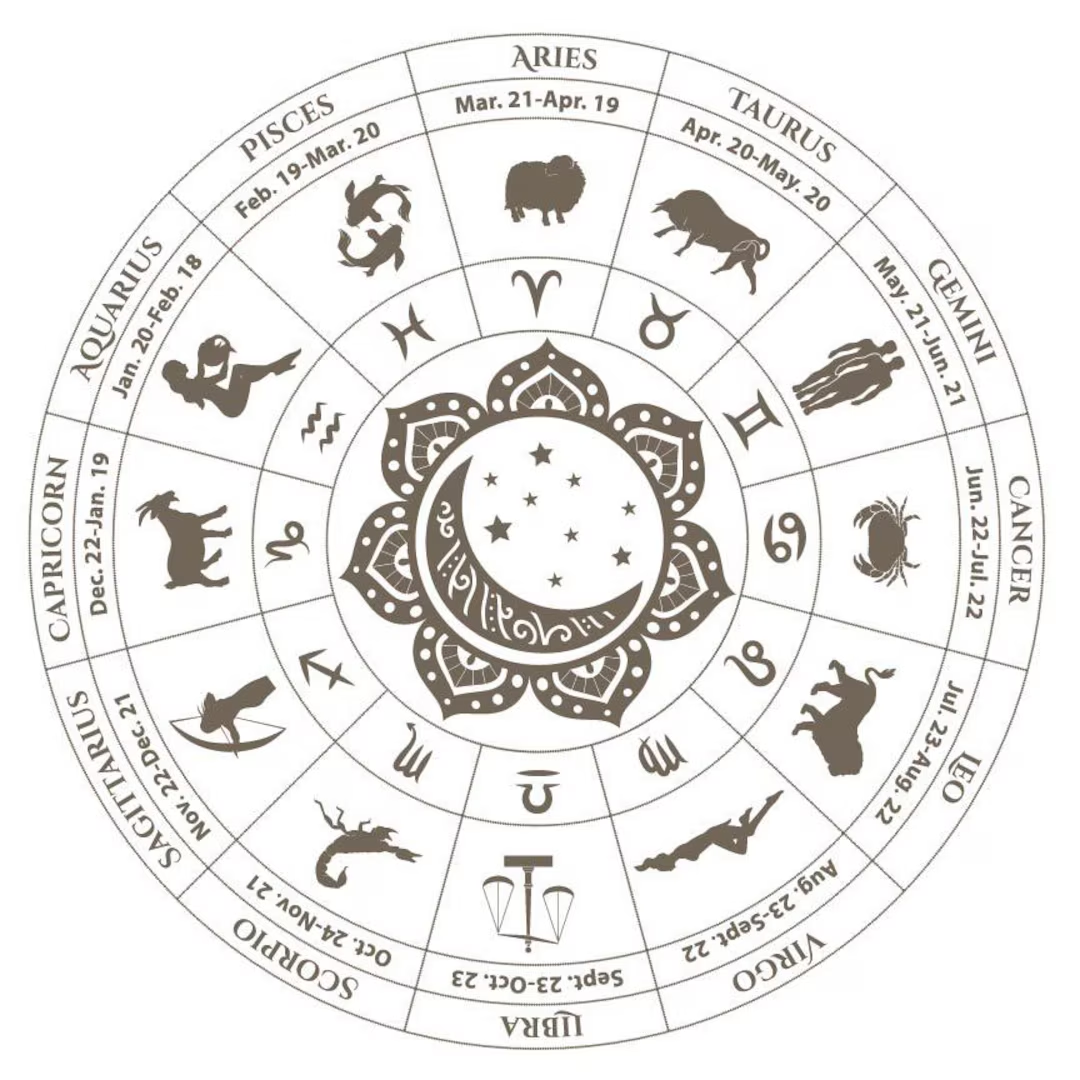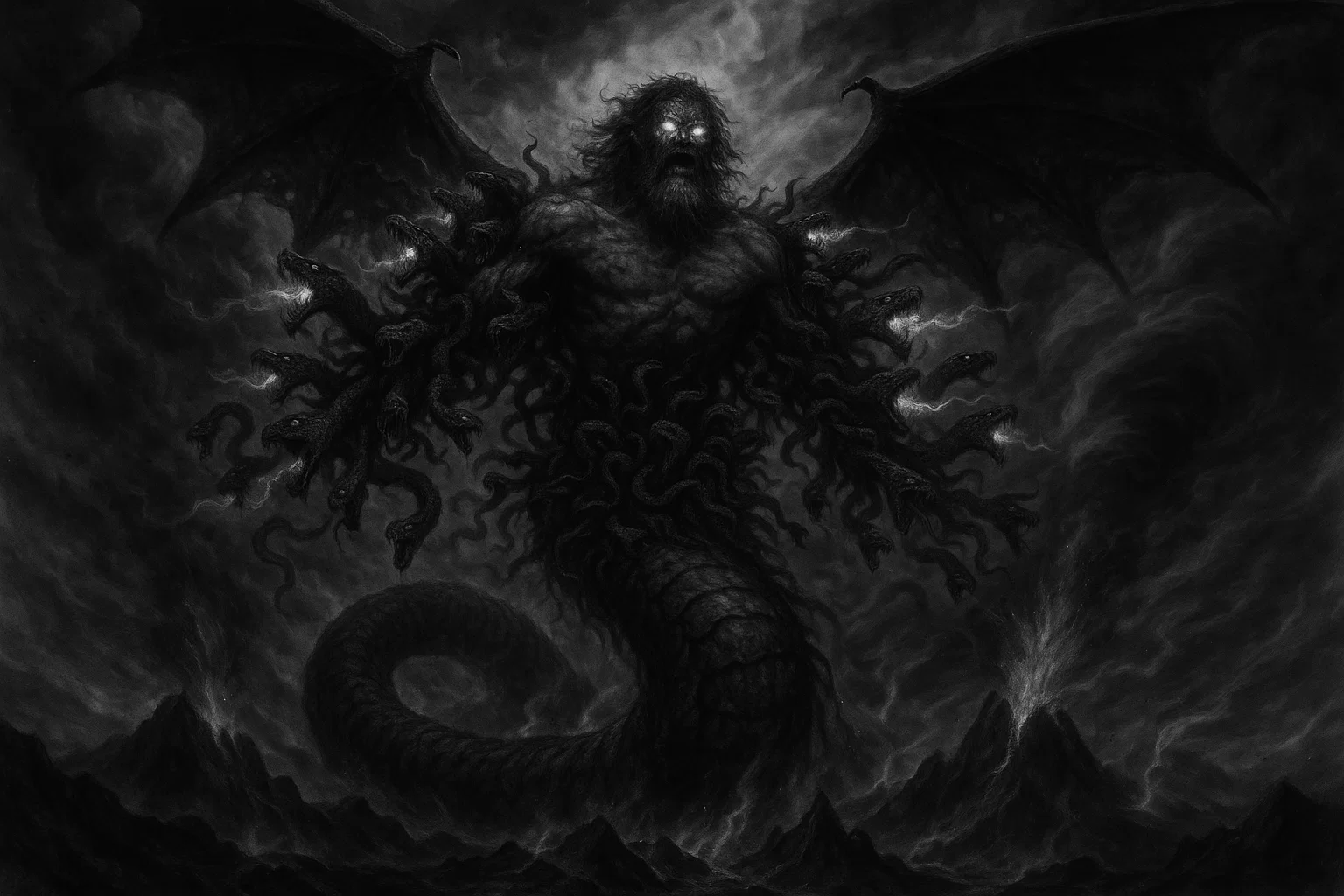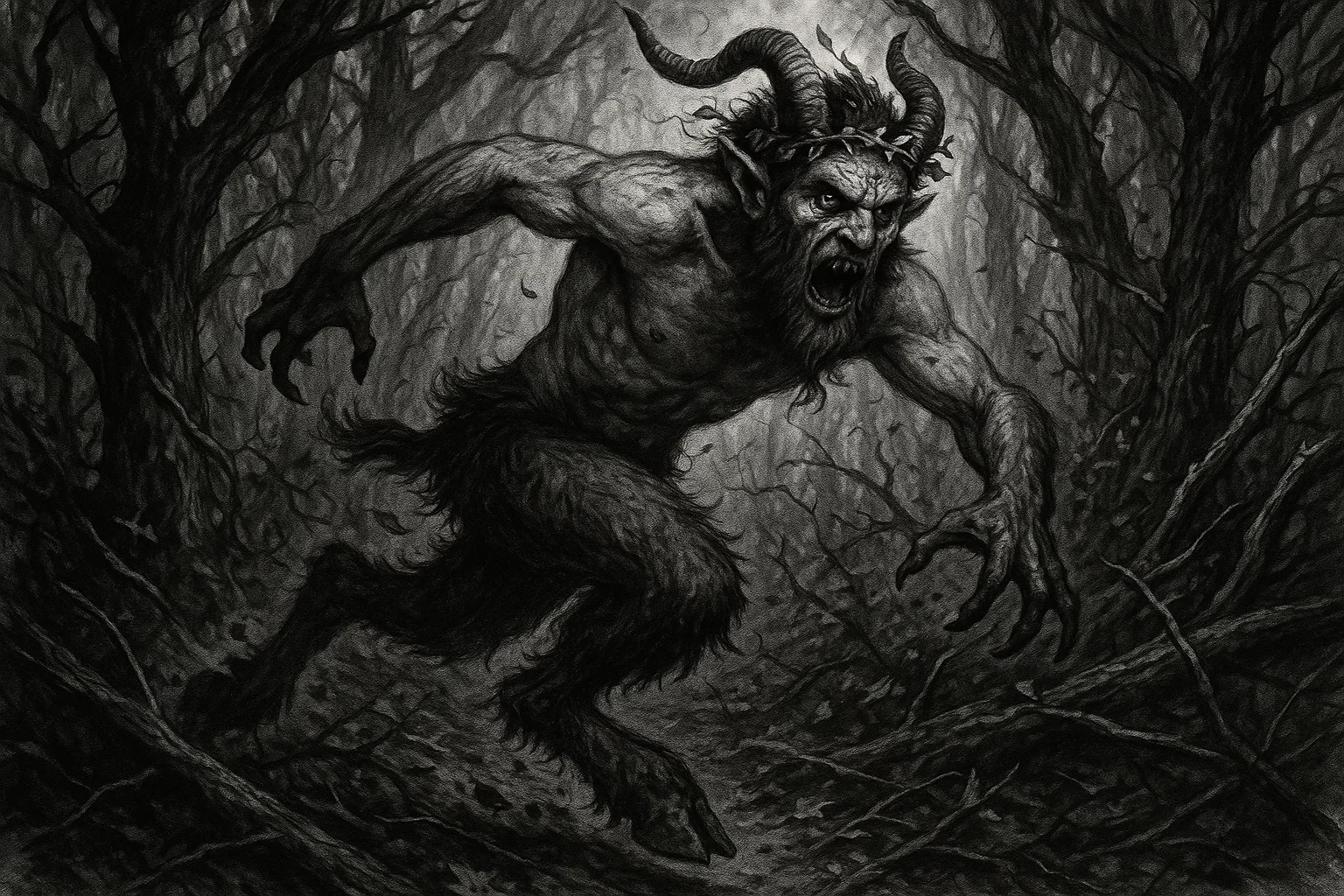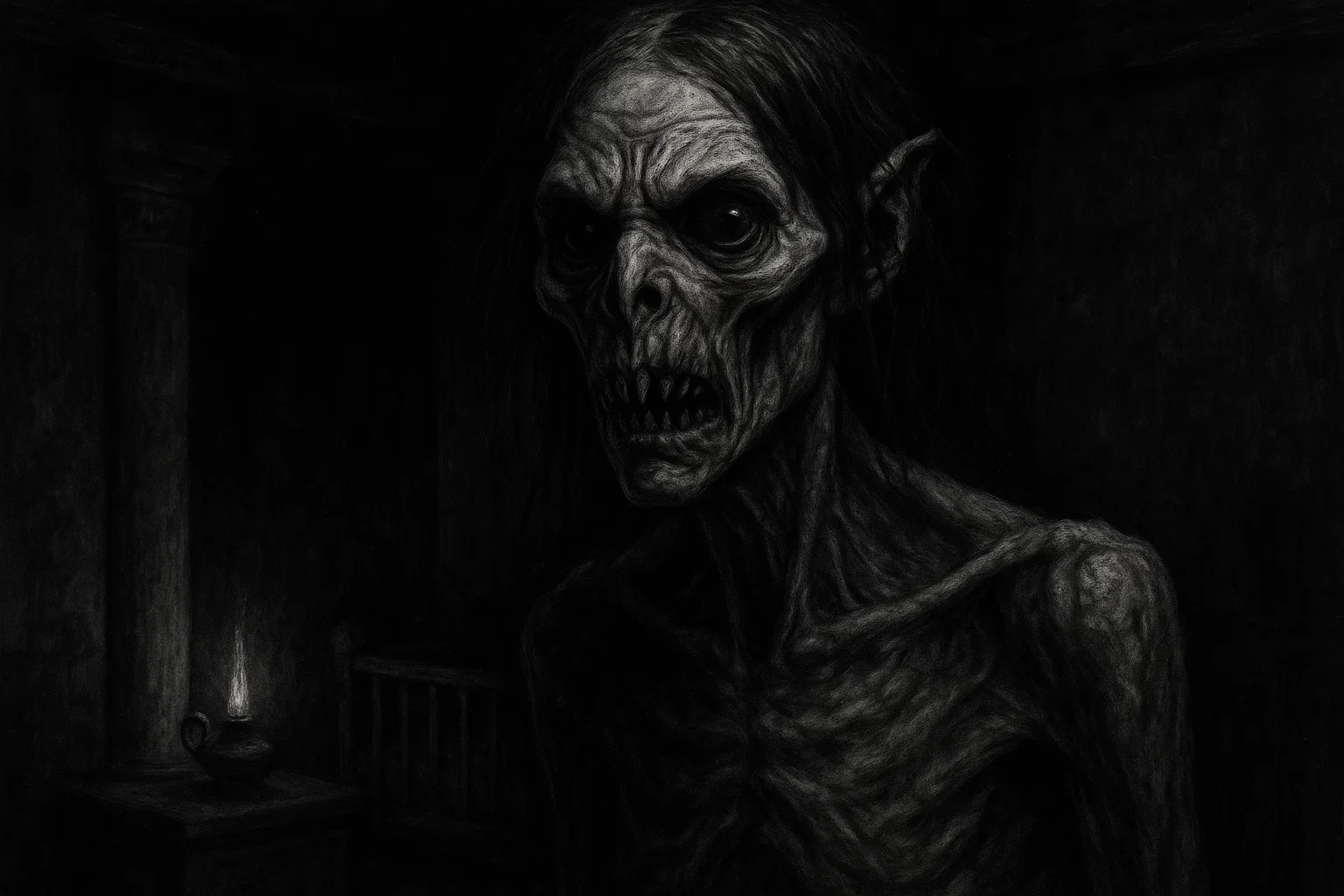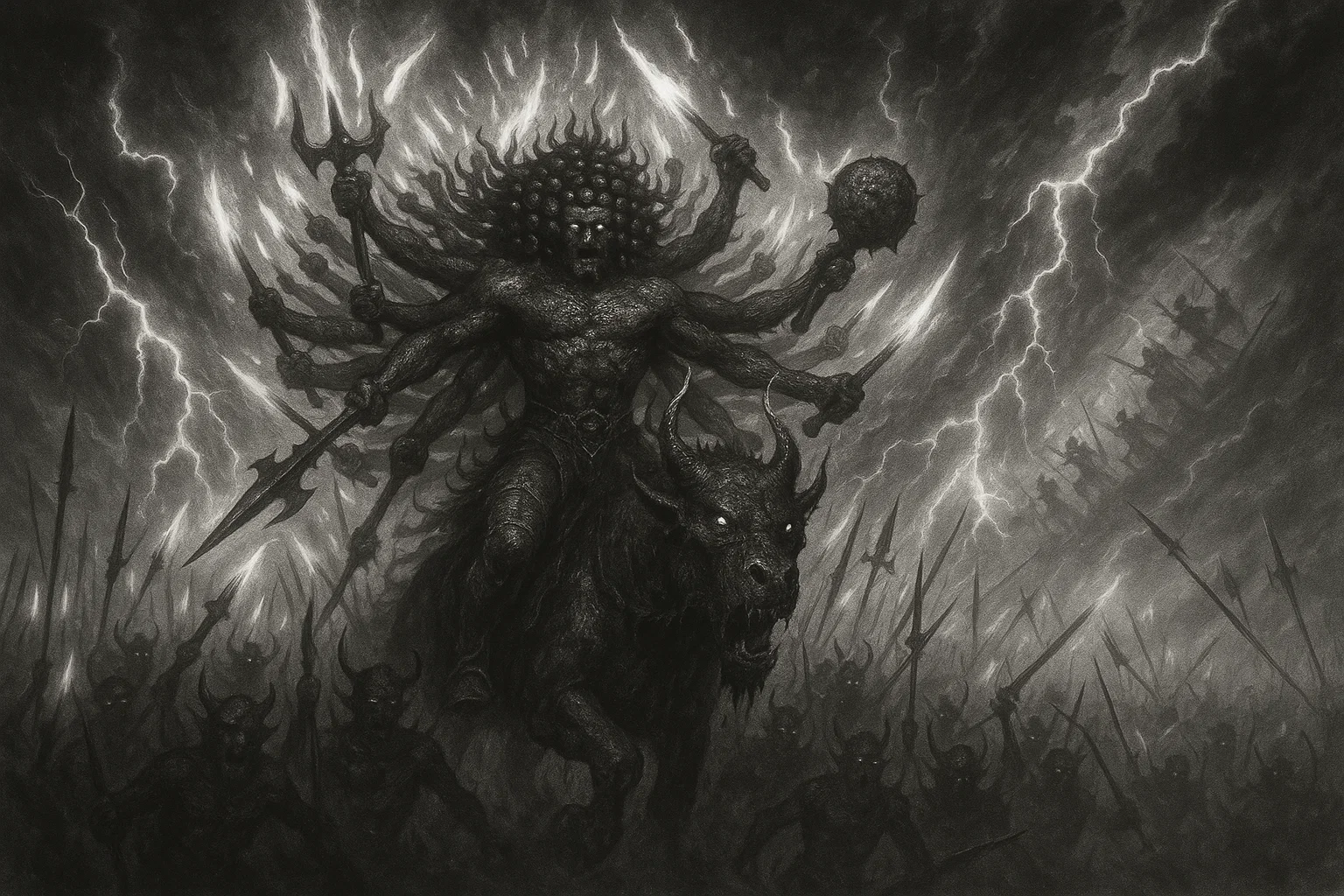Scylla (Ancient Greek: Skylla) is a legendary sea monster featured prominently in Classical Greek mythology, notably in Homer’s epic poem, the Odyssey.
This monster is consistently depicted as an irresistible, man-eating predator, responsible for the loss of countless lives, including six of Odysseus’s companions.
In the earliest accounts, she is presented simply as an immortal, destructive force born of other primordial deities or monsters. Later, Hellenistic and Roman retellings expanded her history, establishing a backstory in which she was originally a beautiful nymph tragically transformed into her monstrous form by divine jealousy and powerful witchcraft, typically associated with the sorceress Circe.
The creature is universally known for inhabiting one side of a narrow, perilous strait, directly opposite the whirlpool monster Charybdis. This placement created an unavoidable maritime hazard, forcing sailors to choose between two destructive outcomes.
Summary
Key Takeaways
| Attribute | Details |
| Names | Scylla, Skylla; Roman writers sometimes referred to her as Ceto. Etymological roots are potentially tied to the Greek skylax (puppy or dog-shark) and skyllō (to tear or to rend). |
| Nature | Irresistible monster, female chthonic/marine daemon. |
| Species | Hybrid Sea Monster (Mischwesen). |
| Appearance | Six long necks, six grisly heads, each featuring a triple row of sharp teeth; twelve dangling feet or tentacles; a body likened to a dog or serpent, sometimes with canine fore-parts girdling the waist. |
| Area | The narrow channel of water opposite Charybdis; later localized to the Strait of Messina, between Calabria and Sicily. |
| Creation | In early accounts, she was born a monster from primordial sea deities. In later accounts, she was a beautiful Naiad nymph cursed and transformed by the sorceress Circe or the goddess Amphitrite. |
| Weaknesses | No certain weaknesses are recorded for permanently repelling or killing her in the most prominent myths. Heracles briefly slew her, but she was resurrected by her father. |
| First Known | 8th century BCE, in Homer’s epic poem, the Odyssey (Book XII). |
| Myth Origin | Classical Greek Mythology and Roman mythographic traditions. |
| Diet | Sailors (six men per passing ship), dolphins, sharks, and various large sea beasts (kētē). |
| Habitat | A large, high cave hidden within a sheer cliff face located above the water, allowing her heads to strike passing ships. |
| Strengths | Immortality (or near-immortality), immense strength, swift speed and agility in the water, and the ability to snatch six victims simultaneously. |
Who or What Is Scylla?
Scylla is a predatory, immortal sea monster in Greek mythology, a permanent maritime threat. She is the terrifying counterpart to the whirlpool Charybdis, with both creatures residing within a short distance of each other in a dangerous strait.
This physical positioning establishes Scylla as the embodiment of an irresistible and unavoidable peril; any ship attempting to navigate the passage is guaranteed to suffer loss, whether by Scylla’s heads or Charybdis’s destructive suction.
In the earliest Homeric tradition, Scylla is a primordial being, a monstrous entity by birthright, living in a dark cave far removed from the civilized world. Her function is purely destructive, acting as an ancient, relentless natural hazard.
Later writers, particularly the Roman poet Ovid, softened this portrayal by introducing a transformation narrative. This widely adopted version explains that Scylla was once a beautiful sea nymph who was desired by the sea-god Glaucus.
Due to the jealous intervention of the sorceress Circe (who loved Glaucus), Scylla’s bathing pool was poisoned with magical herbs, causing her lower body to erupt into a grotesque circle of snarling dog heads and snake-like appendages.
This duality—victimhood followed by uncontrollable monstrous predation—lends complexity to her role. Still, her function in all canonical texts remains the same: a deadly obstacle that cannot be bypassed without sacrifice.
Your Personalized, Hyper Accurate Moon & Astrology Reading
Limited time offer: Get your FREE, fully personalized Moon & Astrology Reading that takes astrology to a whole new level. Discover the secret depths of your personality, relationships, and true purpose in life.
Genealogy
Scylla’s genealogy is one of the most disputed elements in her mythology, with different ancient authors attributing her birth to various combinations of primordial, divine, and monstrous beings.
| Relative | Name | Source/Relationship |
| Father (Most Common) | Phorcys | Ancient sea-god, brother of Ceto, and child of Gaia and Pontus. |
| Mother (Homeric) | Crataeis | A sea nymph, named by Homer in the Odyssey and sometimes interpreted as a title for Hecate. |
| Mother (Alternate) | Hecate | Goddess of magic and witchcraft. Apollonius of Rhodes names her as the mother alongside Phorcys. |
| Parents (Monstrous) | Typhon and Echidna | The monstrous progenitors of many Greek monsters, according to Hyginus. |
| Parents (Divine) | Poseidon and Crataeis | The sea-god and the nymph, cited by Eustathius. |
| Mother (Rare) | Lamia | Stesichorus, a poet, names the Libyan monster as Scylla’s mother. |
| Sibling/Counterpart | Charybdis | The whirlpool monster, often referred to as her counterpart, although not a biological sibling. |
You May Also Like: What Is Abada? Cryptid, Mysterious Animal, or Just a Legend?
Etymology
The name Scylla, deriving from the Ancient Greek Skylla (Σκύλλα), has an uncertain but suggestive etymology that connects directly to her terrifying nature and physical attributes.
The name is traditionally associated with the Greek noun skylax (σκύλαξ), which means “a young dog” or “a puppy.” This is a highly relevant association, given that the monster is characterized by a high-pitched, yelping bark and the prominence of dog heads surrounding her body. Homer explicitly compares her voice to the sound of a newborn whelp, despite her immense size.
A second linguistic connection traces the name to the Greek verb skyllō (σκύλλω), meaning “to tear,” “to rend,“ or “to mangle.“ This definition accurately reflects Scylla’s predatory behavior, as she uses her six heads and three rows of teeth on each head to tear six men from a ship simultaneously. This interpretation aligns Scylla not just with the canine form but also with the violent destruction she inflicts on sailors and marine life.
By the 14th century, the name had entered Latin and subsequent European languages, retaining its meaning as the proper name for the monster in the Strait of Messina. The location she inhabited is still represented by the town of Scilla in Calabria, Italy.
Ultimately, the name Scylla serves as a direct linguistic symbol combining canine ferocity and lethal tearing.19
What Does Scylla Look Like?
The physical description of Scylla varies across classical sources. Still, all accounts focus on her composite nature as a horror, blending human, canine, and snake-like features.
In the Homeric tradition, Scylla is described as possessing twelve feet (or dangling legs) and six long, serpentine necks. Each neck terminates in a grisly head lined with a formidable triple row of dense, sharp teeth. Her body is concealed deep within her cave, but her voice is described as a high-pitched, unnerving “yelping like a newborn whelp.“ Her form, hidden in the sheer cliff, is not visible in its entirety to passing sailors.
Later artistic and mythological depictions, particularly from the 5th century BCE onward, presented a more feminized appearance. She was often depicted as having the upper torso and head of a beautiful woman, but with a lower body that dissolved into a monstrous chaos.
This lower half included a fish or serpent tail, and, most distinctively, a girdle of six menacing dog protomes (fore-parts) springing from her waist. These canine heads perpetually snarled and barked around her midsection, ready to strike at any nearby prey.
This later visual interpretation became the standard representation of Scylla in Roman and Renaissance art.
You May Also Like: 15 True Ghost Stories You Shouldn’t Read Alone After Midnight
Mythology
The foundational mythology of Scylla dates back to her seminal appearance in Homer’s Odyssey (8th century BCE), where she is established as a central, terrifying fixture of western sea voyages.
In Book XII, the sorceress Circe advises Odysseus on how to navigate the perilous strait: he must choose between the inevitable sacrifice to Scylla or the complete loss of his ship to Charybdis.
Homer presents Scylla as an elemental monster, the daughter of Crataeis, and describes her as an “immortal monster, grim and baleful, savage, not to be wrestled with.” Her creation is left largely unelaborated; she exists as an irresistible force of nature.
Her cavern is situated high in a cliff, allowing her six heads to dart out and snatch prey from passing vessels. This earliest narrative focuses solely on her destructive capacity and the terrifying choice she imposes on mariners.
Following the Odyssey, other sources sought to define her lineage. The monster was frequently associated with the primordial sea gods, with Phorcys (father of many aquatic horrors) often named as her sire, and sometimes the goddess Hecate as her mother.
A major mythological development occurred in the later works of poets such as Ovid (Metamorphoses, 1st century CE), which introduced the transformation myth.
This version established Scylla as a beautiful, mortal sea nymph, a Naiad, who was desired by the sea-god Glaucus, a fisherman who had been transformed into a merman. When Scylla rejected Glaucus, he sought the aid of the sorceress Circe for a love potion. Circe, however, was secretly in love with Glaucus herself.
Driven by jealousy, Circe prepared a baleful potion and poured it into the water of the spring or sea pool where Scylla regularly bathed. After entering the water, Scylla watched in horror as her lower half twisted and transformed into the horrific hybrid creature. This fate drove her mad with rage and sorrow.
Awaken XT is unlike anything you’ve ever tried before…
…it’s based off a closely guarded formula that’s said to be able to supercharge your pineal gland and help you access your untapped inner power. With it’s unique blend of extremely hard to source ingredients, Awaken XT helps support the healthy functioning of your pineal gland, as well as your other organs in your body.
Legends
The Encounter with Odysseus
The most prominent account of Scylla is her encounter with Odysseus and his crew during their return journey from the Trojan War, as detailed in Book XII of Homer’s Odyssey.
The hero was warned by the sorceress Circe beforehand about the perils of the strait and the nature of the two monsters. Circe explicitly advised Odysseus to keep his ship closer to Scylla’s cliff, asserting that it was “Better by far to lose six men and keep your ship than lose your entire crew“ to the swallowing vortex of Charybdis.
Despite the warning, Odysseus armed himself, intending to fight Scylla, but Circe had previously reminded him that the monster was “not of mortal kind; she is a deathless monster, grim and baleful, savage, not to be wrestled with.“
Odysseus, following his protective goddess’s counsel, held his course but neglected to warn his crew of the inevitable sacrifice. As the ship sailed past the massive crag, and the crew stared in dread at the great whirlpool of Charybdis on the opposite side, Scylla took advantage of their distraction.
From her dark cave, Scylla darted out her six heads and snatched six of Odysseus’s best men from the deck of the vessel. The men were seized and lifted, “dangling in the air,“ while they cried out the name of Odysseus one last time.
Odysseus states that it was the “most pitiful sight I ever saw in all my years,” as the men were devoured alive while still struggling. The crew was helpless, and Scylla consumed her allotted prey, allowing the ship to pass through the strait, albeit severely reduced.
You May Also Like: The Japanese Kappa Monster: A Dark Obsession With Humans
The Transformation by Circe and Glaucus
A later, but extremely influential, legend concerning Scylla’s origin is recounted by Ovid in his Metamorphoses. This story explains Scylla’s monstrous state as the result of a magical curse motivated by romantic jealousy.
The legend begins with Scylla, a beautiful nymph who often bathed in a secluded bay on the coast of Italy. The sea-god Glaucus, having recently been transformed into a sea-creature (part man, part fish), became instantly infatuated with her.
Still, she was terrified of his new form and fled to a high headland. Glaucus, unable to pursue her onto the land, retreated to the island of Circe, the witch, and asked her to prepare a potion that would make Scylla return his love.
Circe, who was secretly in love with Glaucus herself, tried instead to dissuade him and redirect his affection toward her, urging him to pursue a goddess who welcomed him rather than a woman who refused him.
When Glaucus resolutely stated, “Sooner shall grass grow in the sea’s bed, and the weed on the mountain-top, than I shall cease to love Scylla,” Circe became enraged by his constancy and her own thwarted passion.
Unable to punish Glaucus, Circe turned her hatred upon Scylla. She prepared a vial of powerful, noxious vegetable juices and poured the poison into Scylla’s favorite bathing spring.
When Scylla later stepped into the cursed water, she felt a burning sensation in her loins. She looked down and saw that her lower body was transforming into a horrific mass of barking, snarling dogs and snake-like tails.
In despair, she tried to flee her own monstrous form, but the dogs were now part of her body. The transformation drove the once-beautiful nymph mad, and she subsequently fled to the strait, where she took her vengeance on all passing mariners.
The Attack and Death by Heracles
A far less-known tradition, recorded in a late Greek myth preserved by Eustathius and John Tzetzes, describes an encounter between Scylla and the hero Heracles (Hercules). This event is placed during Heracles’ journey back from his tenth labor, the quest to acquire the Cattle of Geryon.
Heracles, driving the magnificent cattle through the strait, encountered Scylla, who predictably attacked the passing herd and devoured some of the prized oxen. Enraged by the monster’s destruction of his sacred quest animals, Heracles engaged her in battle and, utilizing his legendary strength, slew Scylla.
However, Scylla’s death was not permanent. Her father, the powerful sea-god Phorcys, appeared after the battle and resurrected her by burning her body with torches or magical fire.
You May Also Like: Ittan-momen: The Flying Cloth Yokai That Strangles Victims
Scylla vs Other Monsters
Scylla belongs to a class of female, serpentine, and often hybrid monsters in Greek mythology that personify natural chaos or the punishment for divine disobedience.
| Monster Name | Origin | Key Traits | Weaknesses |
| Charybdis | Greek | Vortex/Whirlpool monster; three times daily swallows and spews the sea. | None; avoidance is the only defense. |
| Lernaean Hydra | Greek | Serpent with many heads (seven to nine); cut heads regrow doubled. | Cauterization of neck stumps; only one mortal head. |
| Gorgon (Medusa) | Greek | Female with serpentine hair; gaze turns viewers to stone. | Reflection/shield; slain by Perseus. |
| Lamia | Greek/Libyan | Female child-eating demon; serpent-woman form; transformed queen. | Zeus granted her the ability to remove her eyes to sleep. |
| Sirens | Greek | Bird-women or mermaid forms; lure sailors to death with irresistible song. | Wax-plugged ears (crew); binding oneself to the mast (Odysseus). |
| Echidna | Greek | Mother of many monsters (Chimera, Sphinx, Cerberus); half-nymph, half-spotted snake. | None specified; sometimes assumed immortal or killed by gods. |
| Sphinx | Greek/Egyptian | Woman’s head, lion’s body, eagle’s wings; guards city gates. | Solving her riddle; defeated by Oedipus. |
| Typhon | Greek | Father of monsters; gigantic; a hundred snake heads; volcanic embodiment. | Slain by Zeus’s lightning bolts (thunderbolt). |
| Ketos (Cetus) | Greek | Vast sea beast or sea serpent; often sent by Poseidon to ravage coasts. | Heroic intervention (e.g., Perseus or Heracles). |
Scylla shares similarities with her mythological counterparts primarily through her hybrid form and her identity as a destructive, mainly female marine or chthonic entity. Like the Hydra, she possesses multiple heads used for predation. Like Echidna and Typhon, she is rooted in the chaotic, monstrous lineage of Greek myth.
Furthermore, her later tragedy connects her to Lamia and Medusa, both beautiful women cursed and transformed by divine jealousy or misconduct.
However, she distinguishes herself from monsters like the Sirens and the Sphinx, who use deception or cunning (song and riddles, respectively).
She operates through brute force and positional advantage. She neither lures nor negotiates; she strikes with terrifying, inevitable physical violence.
Unlike most monsters who can be permanently defeated by a hero (e.g., Medusa or the Hydra), Scylla, in the Homeric and later Heracles traditions, possesses an immortality that renders her a perpetual, recurring hazard to all who sail the dangerous strait.
You May Also Like: Fenrir: The Bound Beast Waiting for Ragnarök
Powers and Abilities
Scylla possesses powers and abilities tailored specifically to her function as an irresistible, static maritime threat. Her strength is primarily physical and structural, arising from her monstrous form and advantageous position within the narrow strait. She operates as a perfected ambush predator, relying on proximity, stealth, and speed to secure her prey.
Her most critical attribute is her immortality, derived from her lineage as the offspring of primordial deities such as Phorcys and Crataeis. Although some sources suggest she was temporarily slain by Heracles, her father’s immediate power of resurrection demonstrates that she is fundamentally a deathless entity, ensuring her permanent role as a hazard in the mythological landscape.
Her physical construction, featuring six separate, independently darting heads attached to long necks, provides her with an exceptional capacity for simultaneous capture, ensuring that she claims six lives with every successful attack on a ship’s crew.
Powers and abilities:
- Irresistible Predation: Scylla’s most defining trait is her capacity to strike with certainty. Her position opposite Charybdis ensures that sailors must pass within her striking range.58 The monster’s speed, combined with the length of her necks, allows her to seize six men from a moving ship before they can react.
- Physical Strength and Dentition: Her heads are capable of overpowering fully grown men, and her triple rows of teeth are described as being able to rend and consume her victims instantly.
- Immortality and Resurrection: As a creature of ancient, divine lineage, Scylla is not subject to normal mortality. Even when slain by the power of Heracles, her sea-god father, Phorcys, was able to revive her using sacred fire.
- Intimidation (Voice): Her voice, described as the “yelping of dogs,“ is used to sow fear and confusion, masking the threat’s severity due to the disparity between the sound and her monstrous size.
- Marine Agility: Scylla is known to prey on large marine creatures (such as dolphins and sharks), implying considerable speed and agility when maneuvering her heads and tentacles underwater, despite being partially rooted in her cave.
Can You Defeat a Scylla?
The possibility of definitively defeating Scylla is consistently framed in classical texts as either impossible or temporary. Her nature as a deathless monster makes traditional methods of confrontation ineffective for securing a permanent victory.
In the Homeric tradition, the answer is a definitive no. Circe explicitly warns Odysseus that Scylla is “not of mortal kind“ and that fighting her would be futile, urging the hero to rely on flight and speed rather than combat.
The most successful approach, as modeled by Odysseus, is to sacrifice a portion of the crew to save the whole vessel, treating the loss as an unavoidable toll exacted by an eternal force.
In a later legend involving Heracles, she is temporarily defeated. The hero’s ability to slay her after she consumed his cattle demonstrates that her physical form can be destroyed by an entity possessing demi-god strength and divine favor.
However, the subsequent resurrection of Scylla by her father, Phorcys, through sacred means, confirms that even a heroic victory does not ensure her permanent removal from the strait.
There are no widely documented magical or ritualistic methods to ward her off, unlike other monsters who fear specific herbs or objects. Therefore, the only viable preventive measure is avoidance of the strait entirely or, failing that, the tactical measure of sailing closest to the monster’s crag while distracting the crew with the threat of Charybdis, as successfully done by Odysseus.
You May Also Like: Cyclops Myths and Real History: Were the Giants of Greece Real?
Conclusion
Scylla is a potent and enduring symbol in classical mythology, embodying the concept of irresistible peril at sea. Her legend, originating in Homer’s Odyssey, establishes her primary function as a predatory, multi-headed sea monster who, alongside Charybdis, creates an inescapable dilemma for ancient mariners navigating the treacherous strait.
This duality cemented the figure’s legacy, giving rise to the proverbial phrase “between Scylla and Charybdis,” signifying a choice between two equally catastrophic outcomes.
Beyond her role as a relentless hazard, later mythological interpretations provided a complex narrative of transformation and tragedy. The accounts detailing her transformation from a beautiful nymph into a raging beast, caused by Circe’s jealousy, introduced themes of divine capriciousness and the devastating consequences of love and betrayal.
Ultimately, Scylla’s enduring presence in the mythological record is secured by her immortality and the unavoidable nature of her attacks. Unlike many monsters who are slain and removed forever, Scylla is presented as an enduring force, capable of resurrection, confirming her status as a permanent, elemental danger against which human strength and wit are often insufficient.


